Analysis of the Water Quality Improvement in Urban Stream Using MIKE 21 FM
Abstract
Featured Application
Abstract
1. Introduction
2. Theoretical Background
2.1. Overview of Ozone Treatment and Stream Water Quality Factors
2.1.1. Stream Water Quality Factors
2.1.2. Overview of Ozone Treatment
2.2. Introduction of the MIKE 21 FM Model
3. Selection and Current Status of the Target Area
3.1. Current Status of the Target Area
3.2. Comparative Analysis of the Observed Water Quality Concentration
4. Model Building and Data
5. Model Verification and Analysis Results
5.1. Setting of the Simulation Conditions
5.2. Model Verification Results
5.3. Model Simulation Results
5.3.1. Comparison of BOD before and after the Supply of the Ozone Treated Reclaimed Wastewater
5.3.2. Comparison of Dissolved Oxygen (DO) before and after the Supply of the Ozone Treated Reclaimed Wastewater
5.3.3. Comparison of Total Nitrogen (TN) before and after the Supply of the Ozone Treated Reclaimed Wastewater
5.3.4. Comparison of Total Phosphorus (TP) before and after the Business
6. Conclusions
Funding
Institutional Review Board Statement
Informed Consent Statement
Data Availability Statement
Acknowledgments
Conflicts of Interest
References
- Choi, J.Y. A Study on Calculating and Securing the Stream Maintenance Water Demand in Urban Watershed. Korea Spat. Plan. Rev. 2001, 32, 63–76. [Google Scholar]
- Ministry of Environment. Study on the Rational Adjustment of Water Quality Standards for Water Reuse Activation; Ministry of Environment: Seoul, Korea, 2009.
- Jee, Y.K.; Ahn, J.H.; Lee, J.H. Urban Instream Flow Augmentation Using Reclaimed Water in Korea. J. Korean Soc. Water Wastewater 2012, 26, 285–294. [Google Scholar] [CrossRef][Green Version]
- Lee, K.S.; Chung, E.S.; Park, S.B.; Jin, L.S. Variations of Runoff Quantity and Quality to Landuse Changes in the Hakuicheon Watershed. In Proceedings of the Korea Water Resources Association Conference, Iksan, Korea, 20–21 May 2005; pp. 664–668. [Google Scholar]
- Lee, K.S.; Jin, L.S.; Lee, S.H.; Lee, J.M. Water Engineering: Provision Measures of Maintenance Water to Prevent Streamflow Depletion Using PCSWMM. J. Korean Soc. Civ. Eng. 2005, 25, 437–441. [Google Scholar]
- Cho, C.W.; Kim, J.T.; Park, J.J.; Song, J.H.; Lee, M.S.; Jeong, J.R.; Ryou, J.W. A Study on Reuse of Reclaimed Water in Jeonbuk Province. J. Korean Soc. Environ. Eng. 2017, 39, 237–245. [Google Scholar] [CrossRef]
- Kim, D.H.; Kim, J.S. Strategies for Improved Reuse of Effluent Water from Wastewater Treatment Plants in Incheon; The Incheon Institute: Incheon, Korea, 2009. [Google Scholar]
- Lee, H.S.; Hur, J.; Jeong, S.A.; Hwang, S.J.; Shin, J.K. Spatial Characterization of Water Pollution in the Urban Stream Watershed (Gap Stream) Korea. J. Korean Soc. Water Qual. 2006, 22, 943–951. [Google Scholar]
- Choi, C.H.; Namkung, K.C.; Youn, J.W.; Lee, C.Y. Improvement of River Water Quality By Combined treatment of Sand Filtration and Ozonation(1)—Focusing on Reduction of BOD, COD, SS and Color. J. Korean Soc. Water Qual. 2011, 27, 813–821. [Google Scholar]
- Jung, J.H. A Study on River Maintenance Water Reuse of Sewage Secondary Effluent by Coagulation-Membrane Separation Process. Ph.D. Thesis, Dong-A University, Busan, Korea, 2009. [Google Scholar]
- Seo, J.B. Effluent Reuse by the serial Processes of Sand Filter/O3/BAC/Zeolite. J. Inst. Nat. Sci. 1998, 5, 219–230. [Google Scholar]
- Mori, Y.; Oota, T.; Hashimoto, M.; Takamura, M.; Fujii, Y. Ozone-microfiltration System. Desalination 1998, 177, 211–218. [Google Scholar] [CrossRef]
- Park, S.J.; Lee, H.G.; Oh, B.S.; Kim, K.S.; Song, S.J.; Joo, S.; Kang, J.W. Evaluation of Ozone and Ozone/UV Processes for the Reuse of Sewage Treatment Plant Effluent. In Proceedings of the KSEE Conference, Daejeon, Korea, 1–3 May 2003; pp. 973–980. [Google Scholar]
- Ahn, G.H.; Park, K.Y.; Maeng, S.G.; Hwang, J.H.; Song, K.K.; Lee, Y.H.; Lee, J.W.; Chung, M.W. Fundamental Study on Ozone Treatment for Reduction and Recycle of Wastewater Sludge. In Proceedings of the KSWW & KSWE Conference, Gwangju, Korea, 13 April 2001; Volume 2001, pp. 41–44. [Google Scholar]
- Yi, L.; Jiao, W.; Chen, X.; Chen, W. An overview of reclaimed water reuse in China. J. Environ. Sci. 2011, 23, 1585–1593. [Google Scholar] [CrossRef]
- Chen, W.; Lu, S.; Jiao, W.; Wang, M.; Chang, A.C. Reclaimed water: A Safe Irrigation Water source? Environ. Dev. 2013, 8, 74–83. [Google Scholar] [CrossRef]
- Gyan Chhipi-Shrestha, G.; Hewage, K.; Sadiq, R. Microbial Quality of Reclaimed Water for Urban Reuses: Probabilistic Risk-based Investigation and Recommendations. Sci. Total Environ. 2017, 576, 738–751. [Google Scholar] [CrossRef] [PubMed]
- Cocoa Florida. Available online: https://www.cocoafl.org/269/What-is-Reclaimed-Water (accessed on 13 September 2021).
- Kang, J.H. A Study on NOD Ratio of Effluent BOD in Sewage Treatment Plant. Master’s Thesis, University of Seoul, Seoul, Korea, 2009. [Google Scholar]
- Kim, J.K. Introduction to Water Pollution; Donghwa Technology: Donghwa, Korea, 2000. [Google Scholar]
- RMB Environmental Laboratories, Inc. Available online: https://www.rmbel.info/primer/total-phosphorus (accessed on 13 September 2021).
- Environmental Engineering Research Association. Dictionary of Environmental Engineering Terminology; Seongandang: Seoul, Korea, 2002. [Google Scholar]
- Water Environment Information System. Available online: http://water.nier.go.kr (accessed on 13 September 2021).
- Bocci, V. How Does Ozone Act? In How and Why Can. We Avoid Ozone Toxicity? Springer: Berlin/Heidelberg, Germany, 2005. [Google Scholar]
- Remondino, M.; Valdenassi, L. Different Uses of Ozone: Environmental and Corporate Sustainability. Literature Review and Case Study. Sustainability 2018, 10, 4783. [Google Scholar] [CrossRef]
- Water Mail. Available online: http://www.watermaeil.com/news/articleView.html?idxno=1695 (accessed on 13 September 2021).
- Bladé Castellet, E.; Cea, L.; Corestein, G. Numerical modelling of river inundations. Ing. Agua 2014, 18, 71–82. [Google Scholar] [CrossRef]
- Pinos, J.; Timbe, L. Performance assessment of two-dimensional hydraulic models for generation of flood inundation maps in mountain river basins. Water Sci. Eng. 2019, 12, 11–18. [Google Scholar] [CrossRef]
- Symonds, A.M.; Vijverberg, T.; Post, S.; Spek, B.V.D.; Henrotte, J.; Sokolewicz, M. Comparison between MIKE 21 FM, Delft3D and Delft3D FM flow models of Western Port Bay, Australia. Coast. Eng. Proc. 2017, 1. [Google Scholar] [CrossRef]
- DHI. MIKE 21 Flow Model Hydrodynamic Module User Guide; DHI: Hørsholm, Denmark, 2017. [Google Scholar]
- Paliwal, R.; Ratra, R.R. Applicability of MIKE 21 to assess temporal and spatial variation in water quality of an estuary under the impact of effluent from an industrial estate. Water Sci. Technol. 2011, 63, 1932–1943. [Google Scholar] [CrossRef] [PubMed]
- Wikipedia. Available online: https://ko.wikipedia.org/wiki/%EA%B5%B4%ED%8F%AC%EC%B2%9C (accessed on 20 August 2021).
- Ahn, T.W.; Jung, J.H.; Kim, T.H.; Kim, S.W.; Choi, I.S.; Oh, J.M. A Study on the Characteristic of Pollutants of Water Quality and Sediments in Gul-po Stream Basin. JKSEE 2012, 34, 495–503. [Google Scholar] [CrossRef]
- Seol, H. Discussion on the Designating Gulpo River as the National River; National Assembly Strategy and Finance Committee: Seoul, Korea, 2013.
- Incheon Environmental Corporation. Available online: https://www.eco-i.or.kr/main/main.asp (accessed on 13 September 2021).
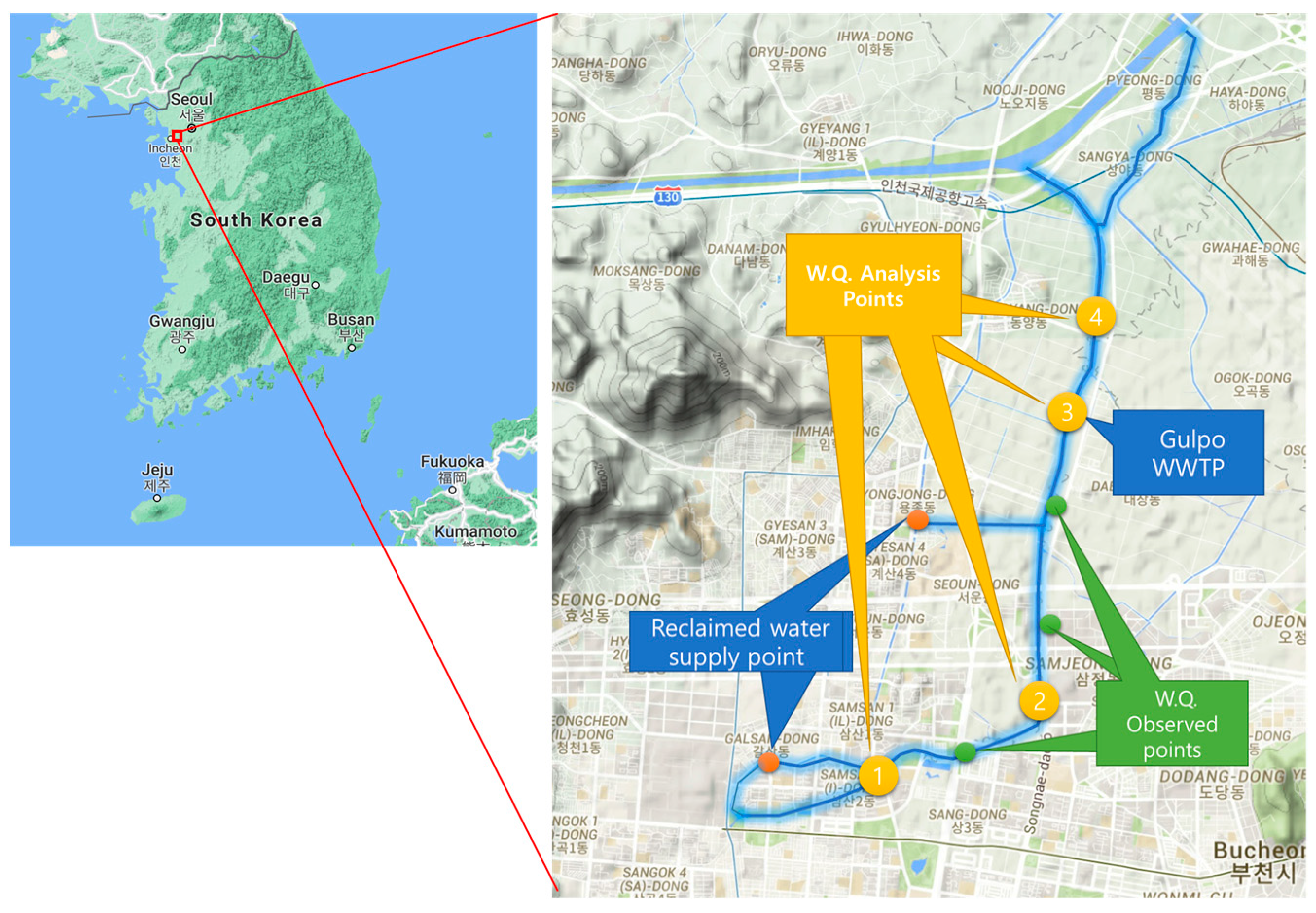
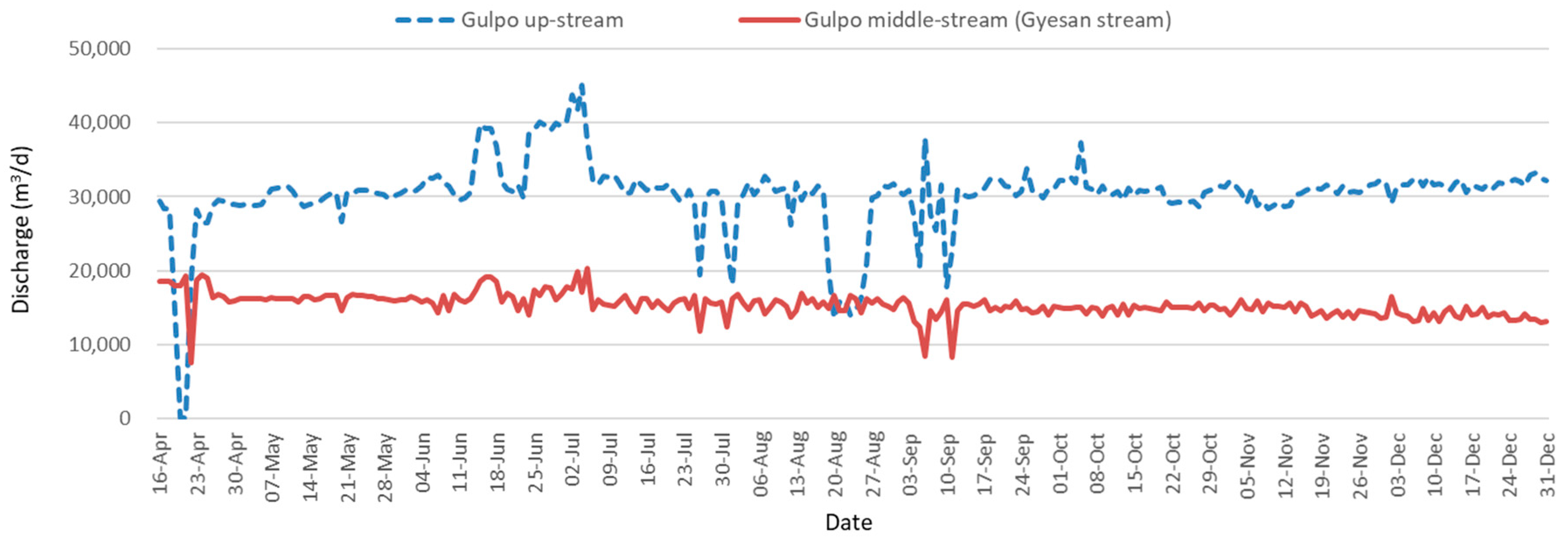
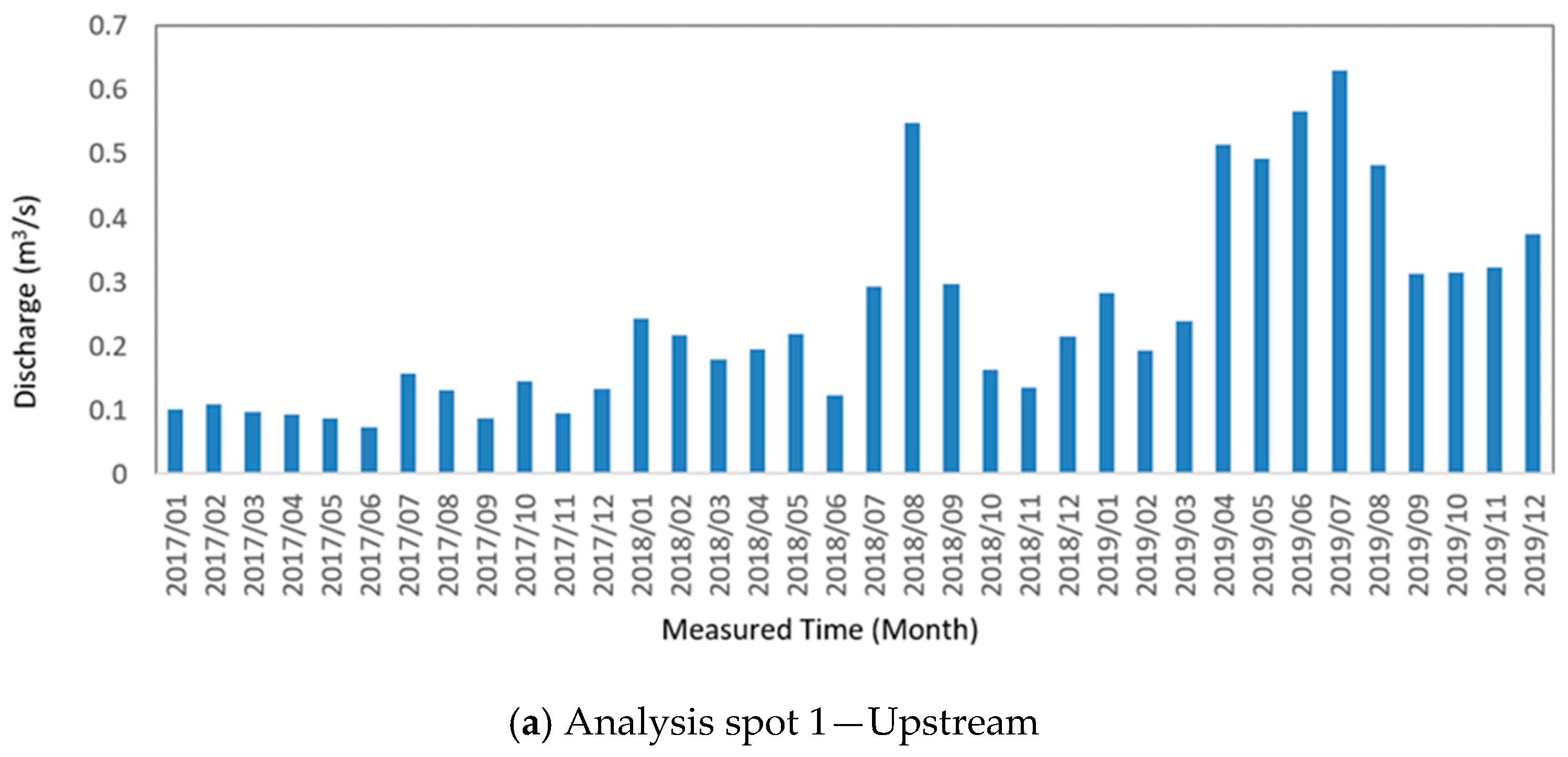
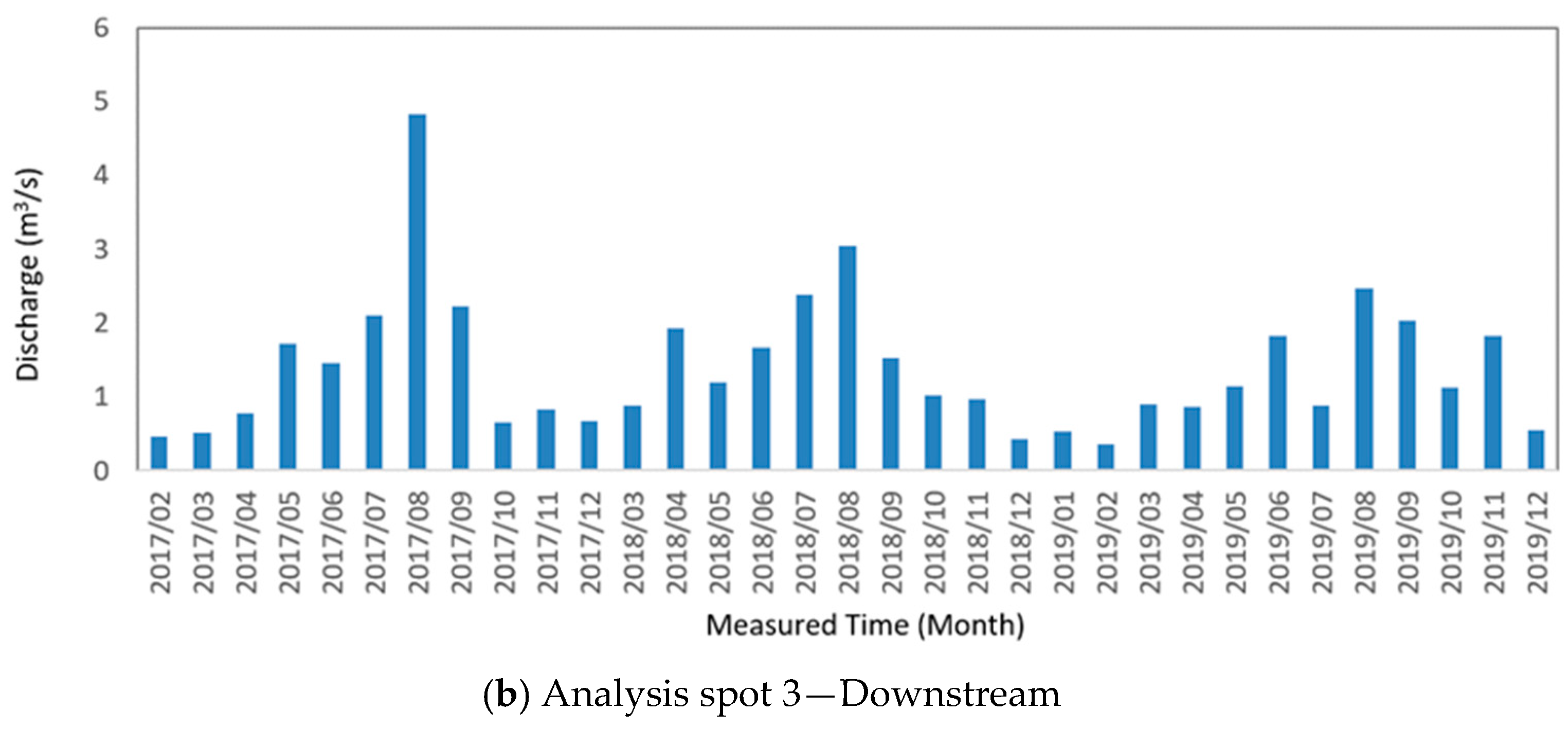
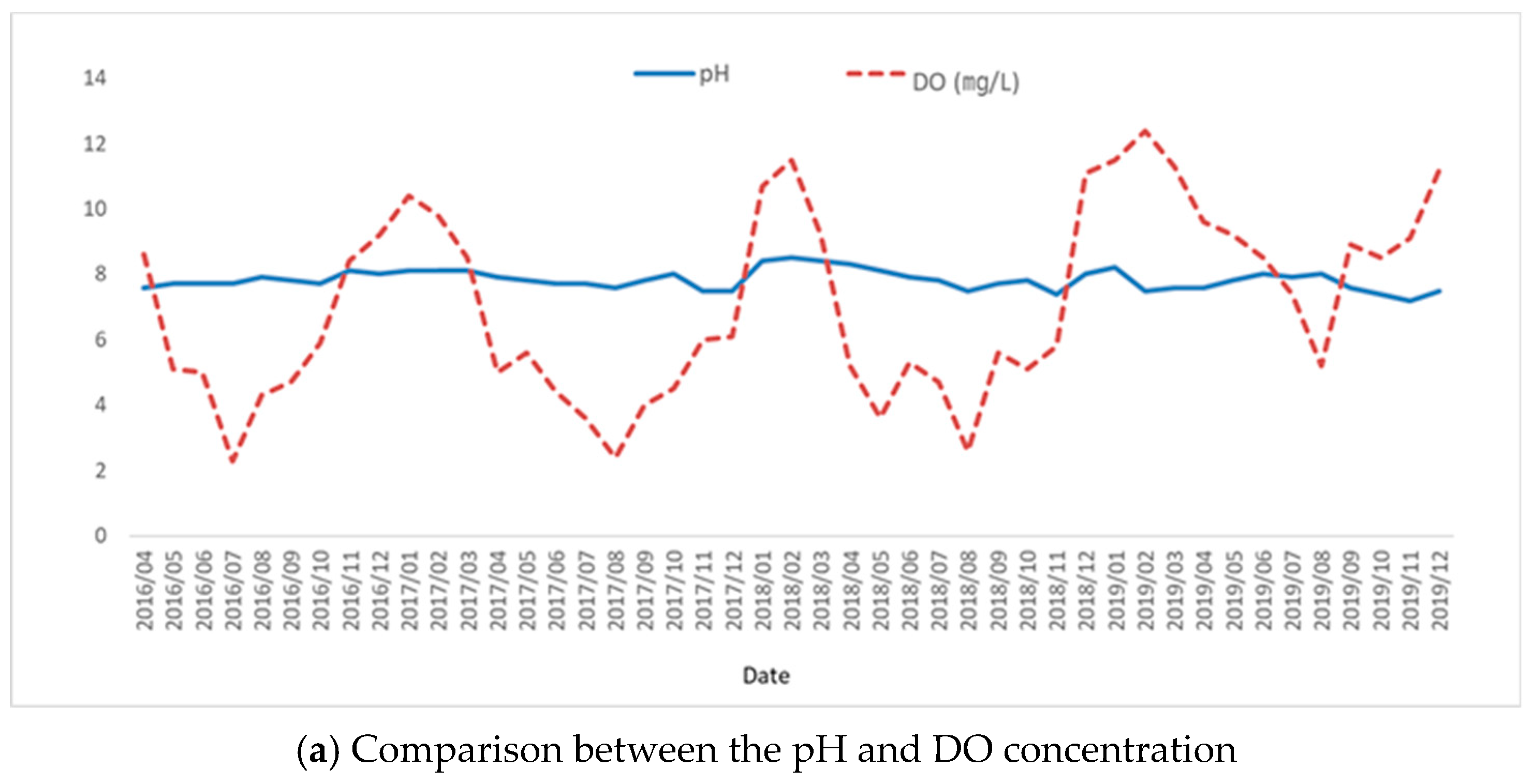
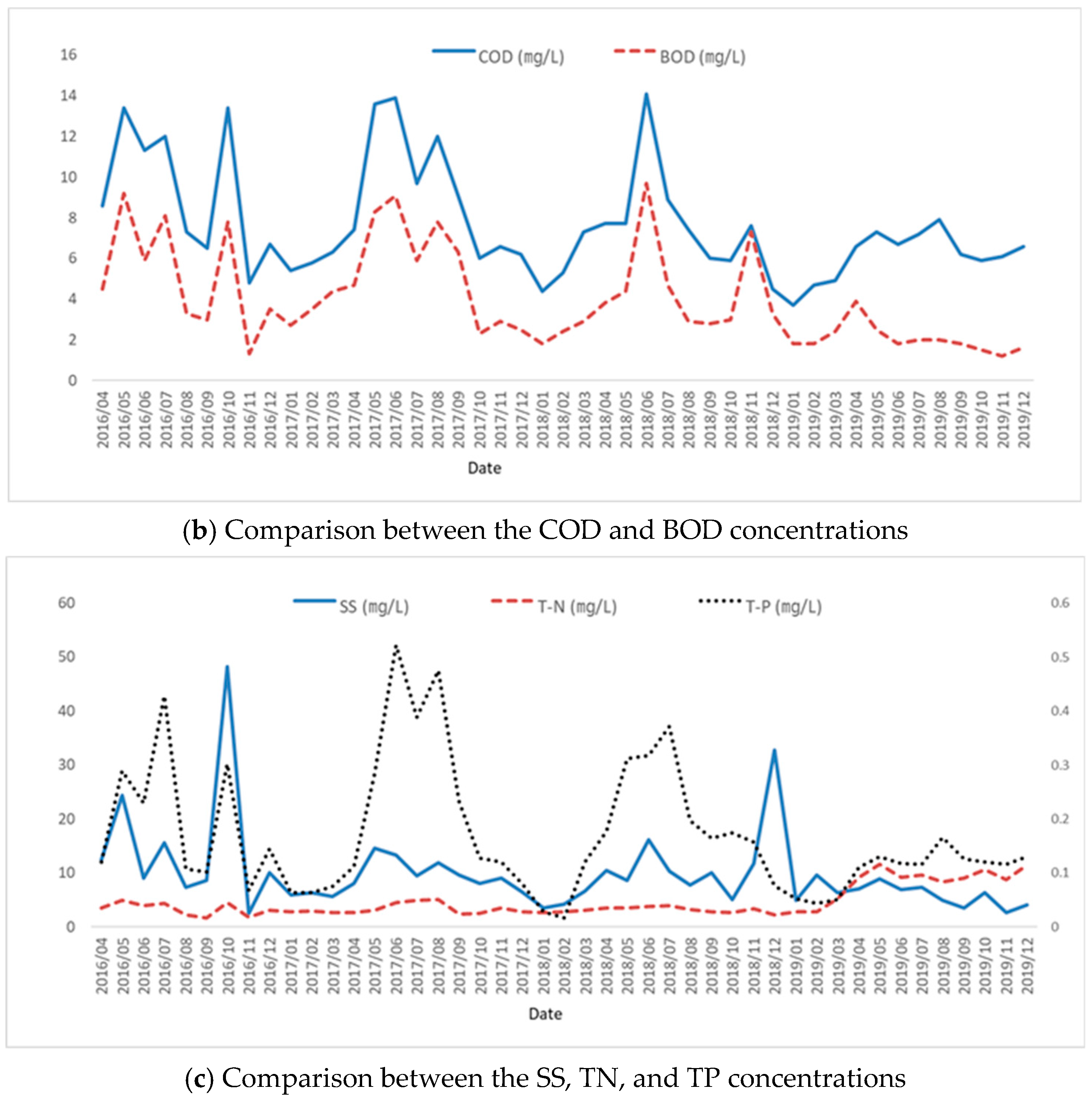
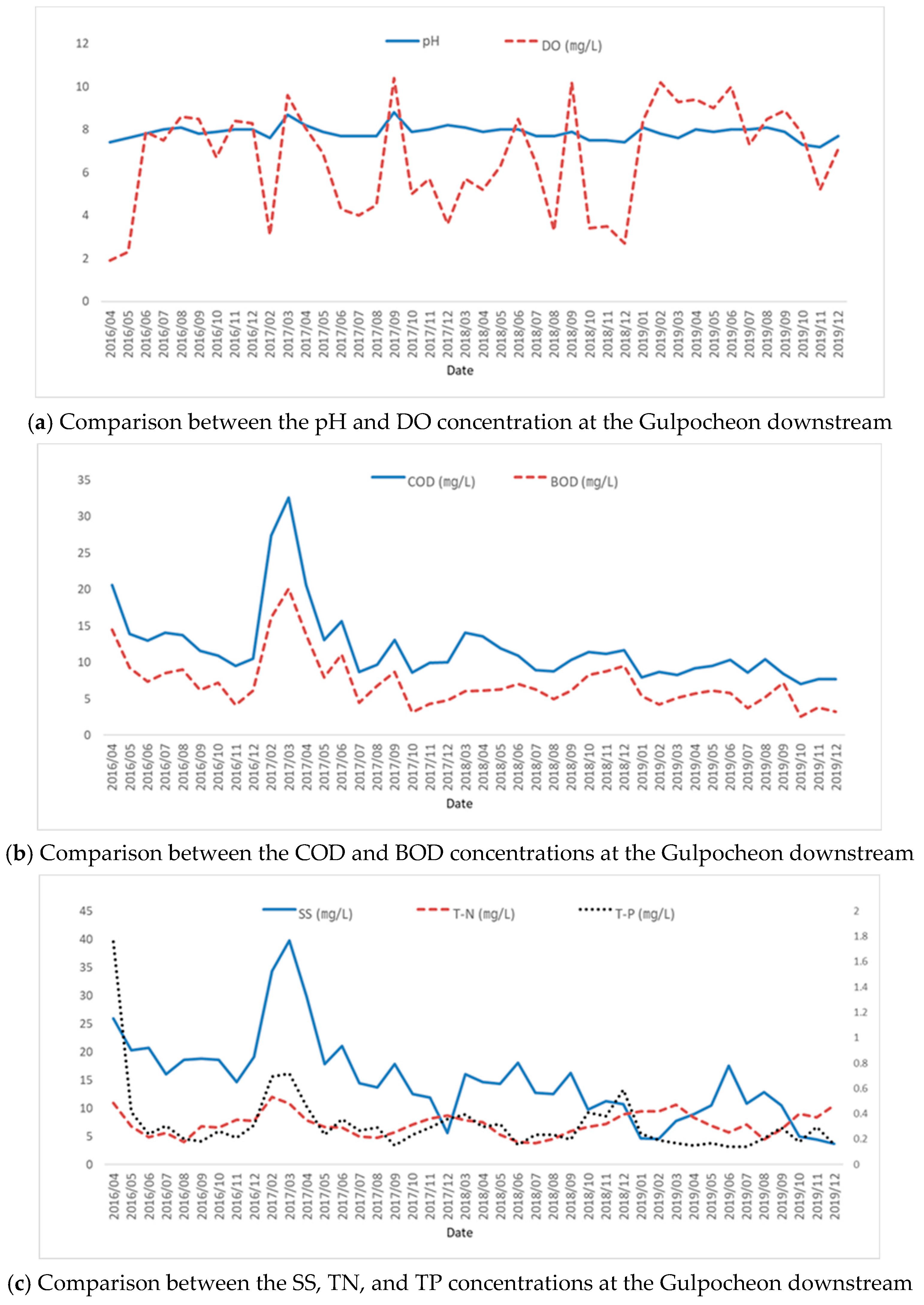

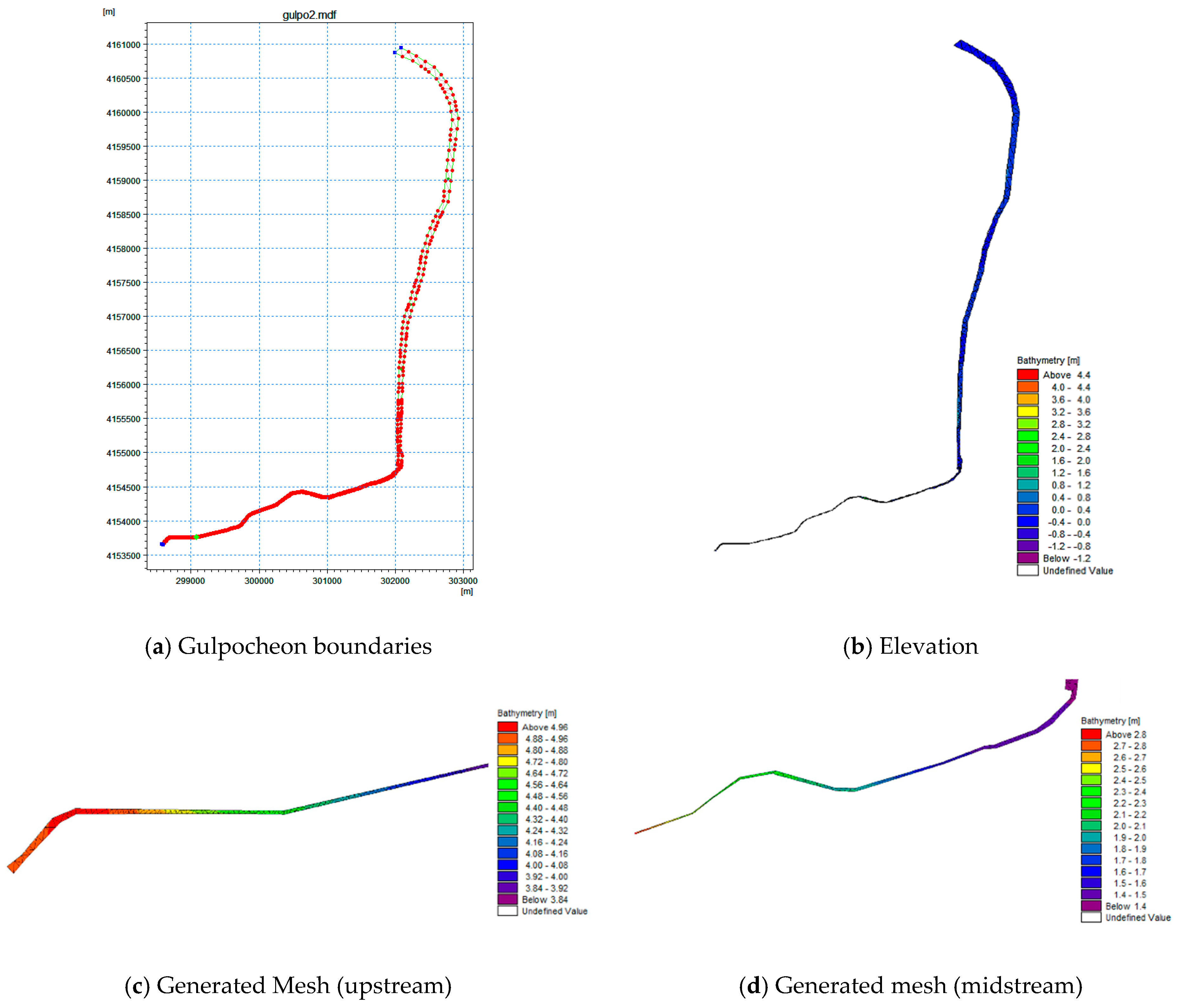
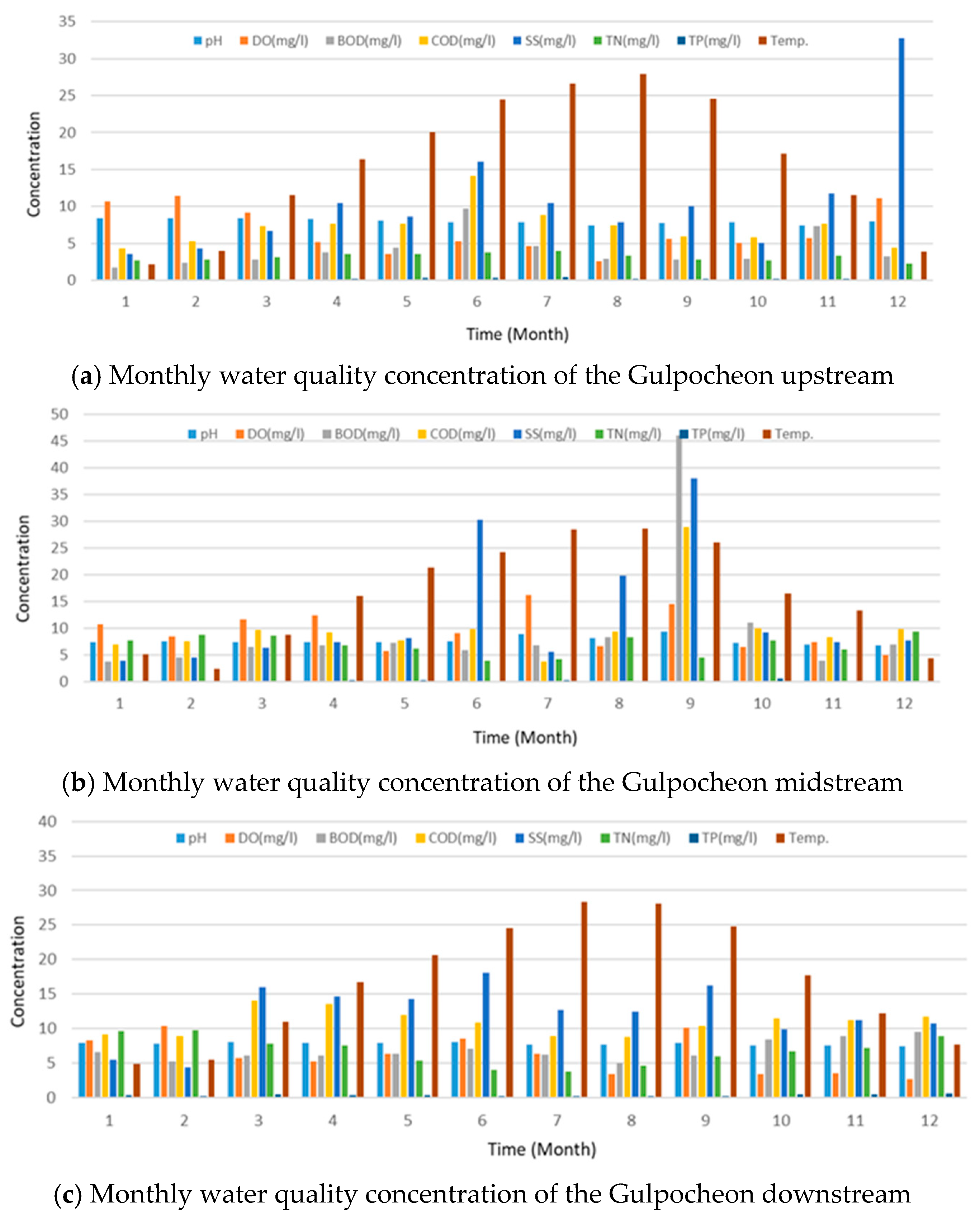
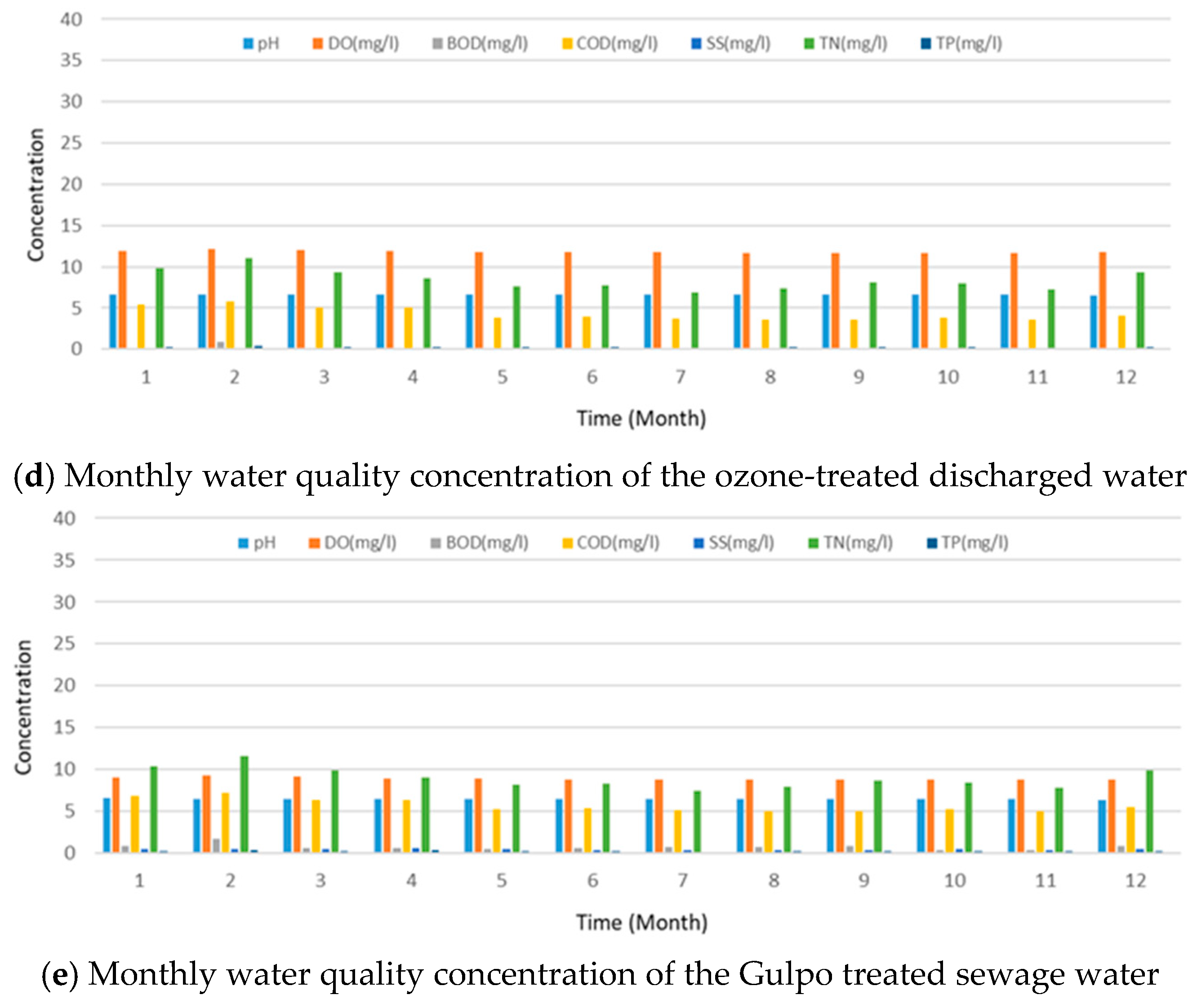

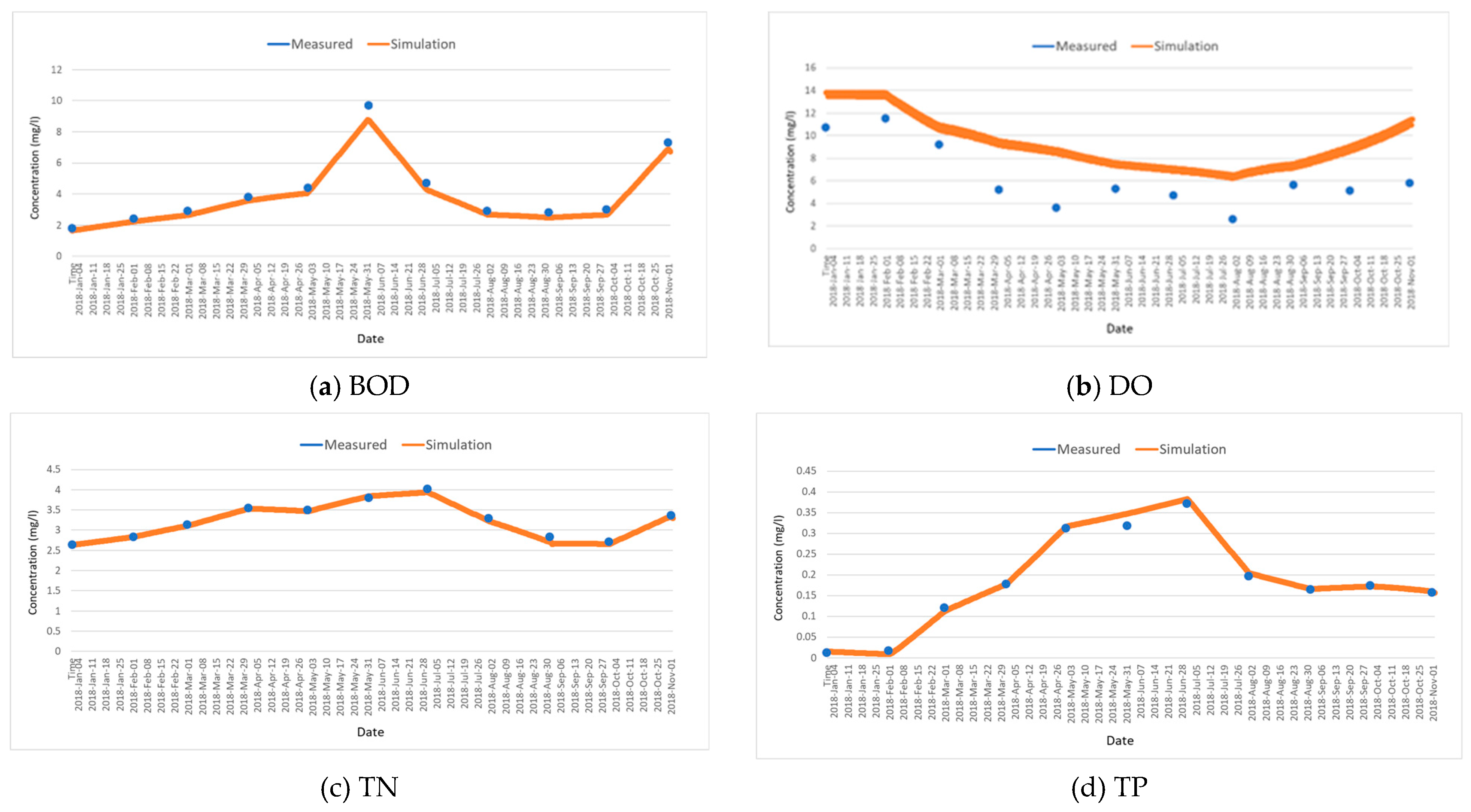
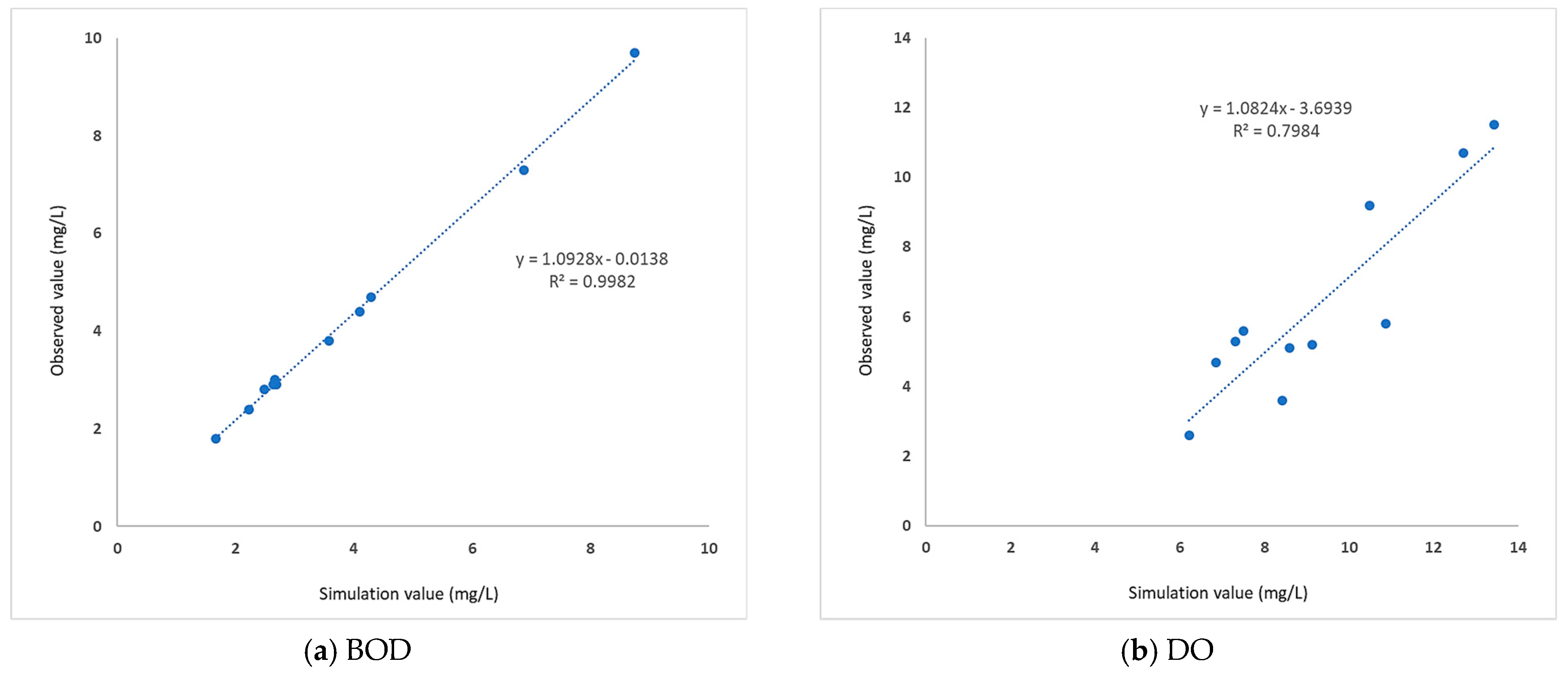
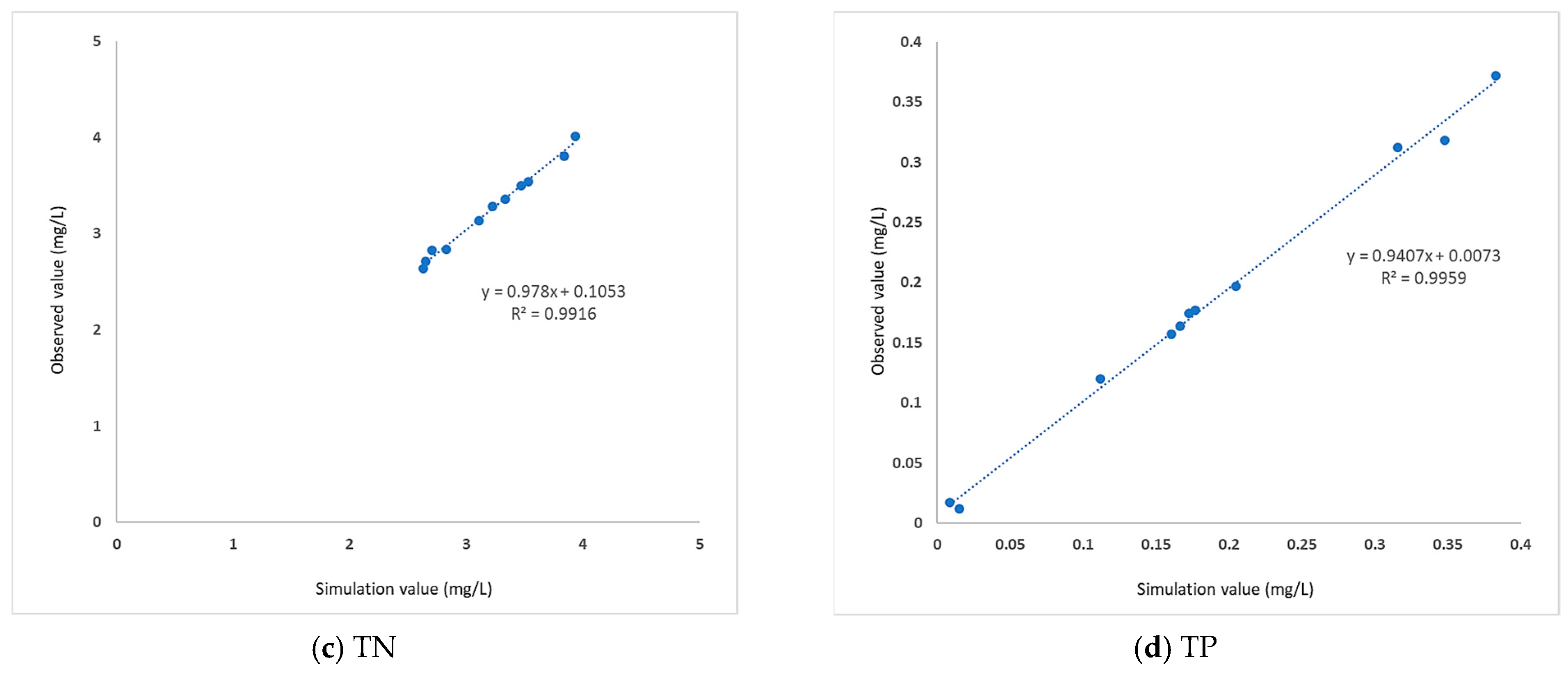
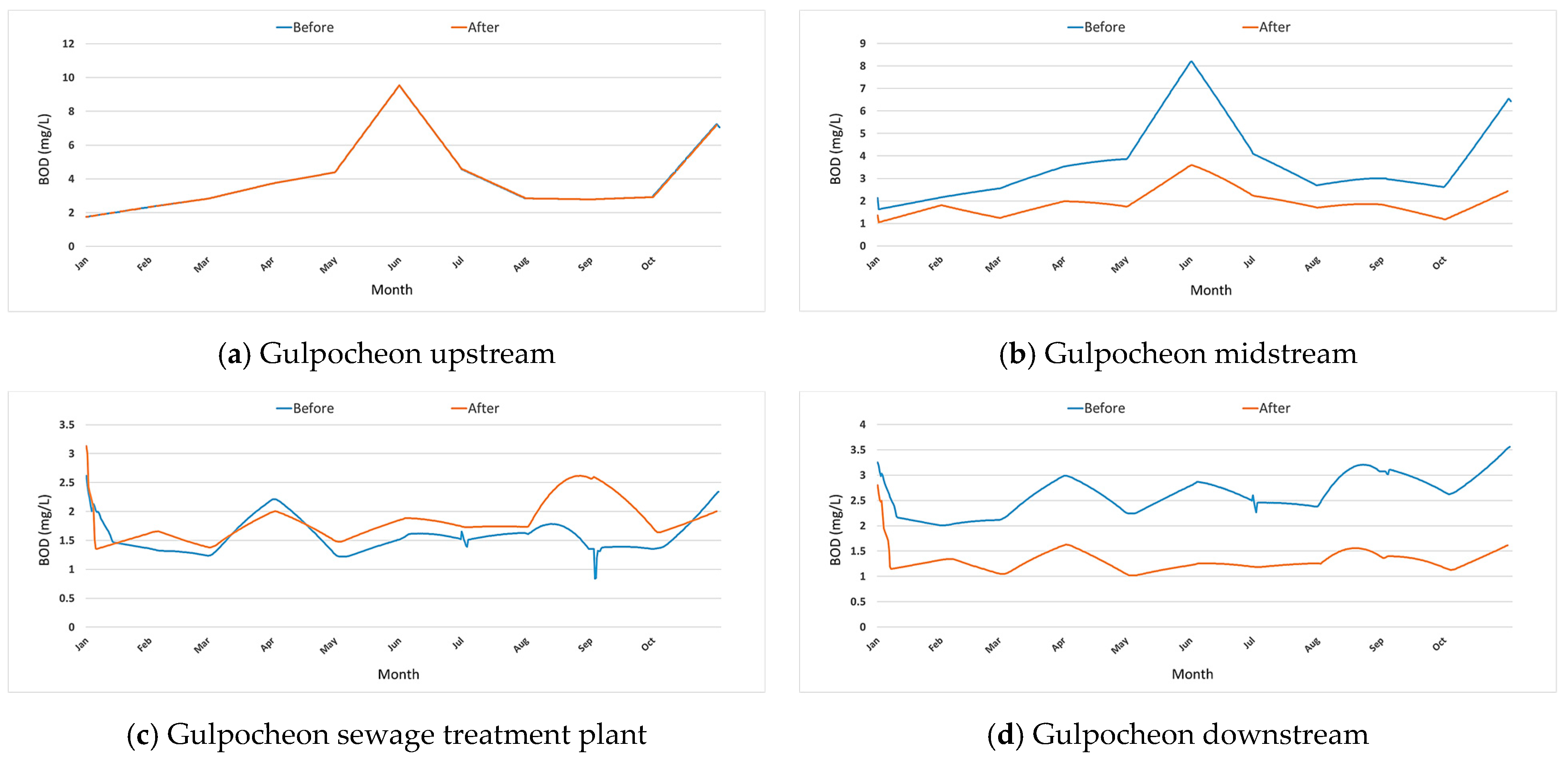
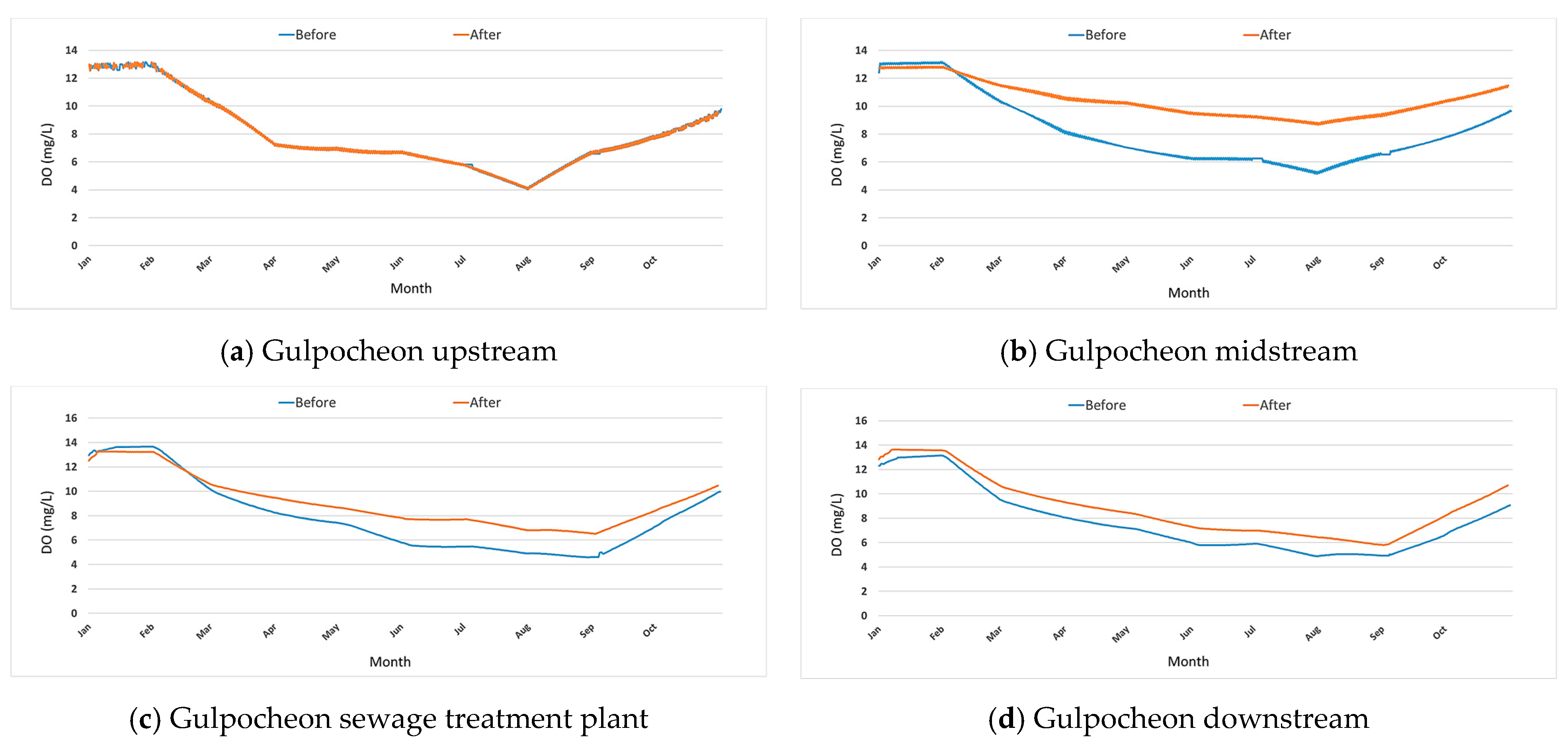
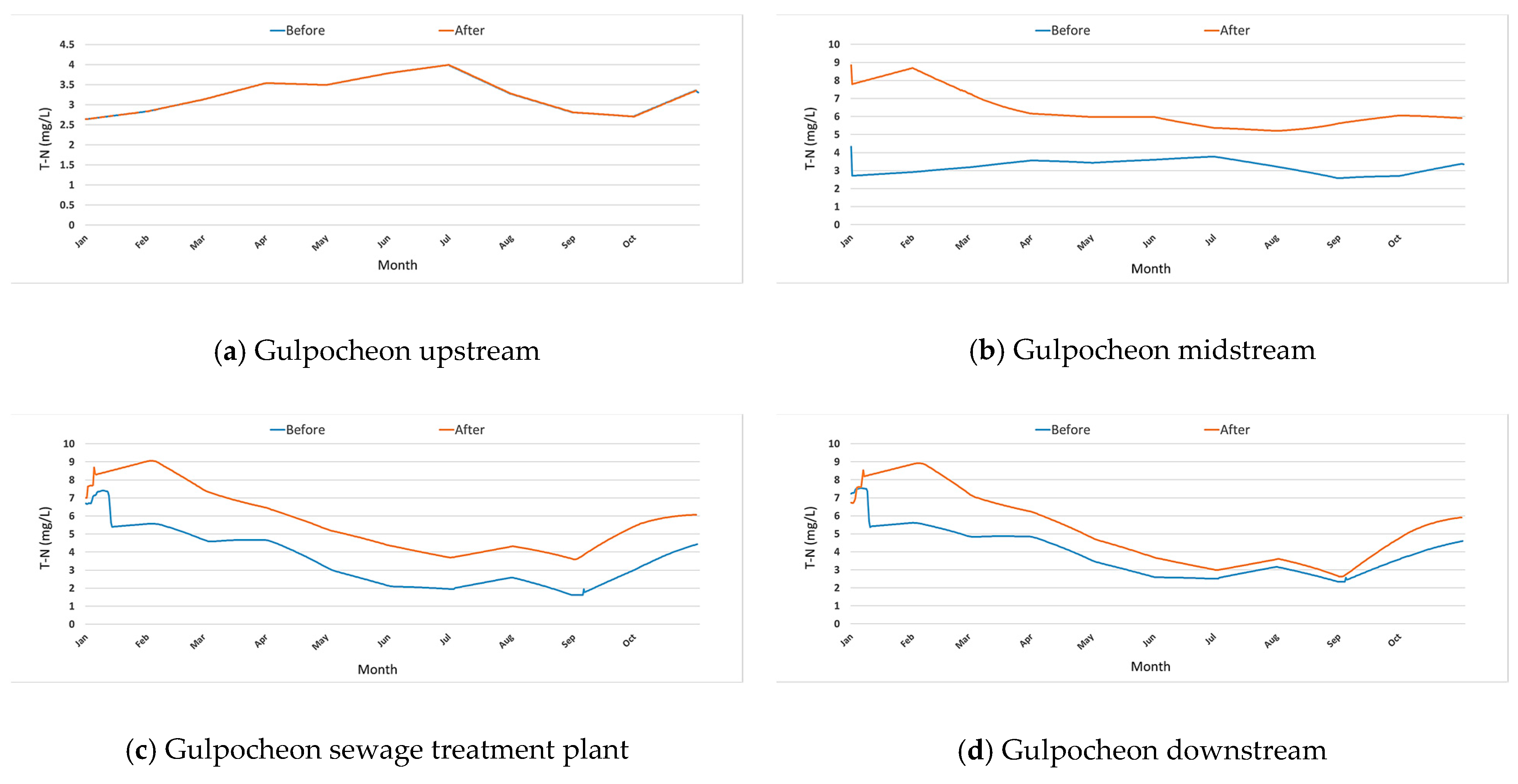
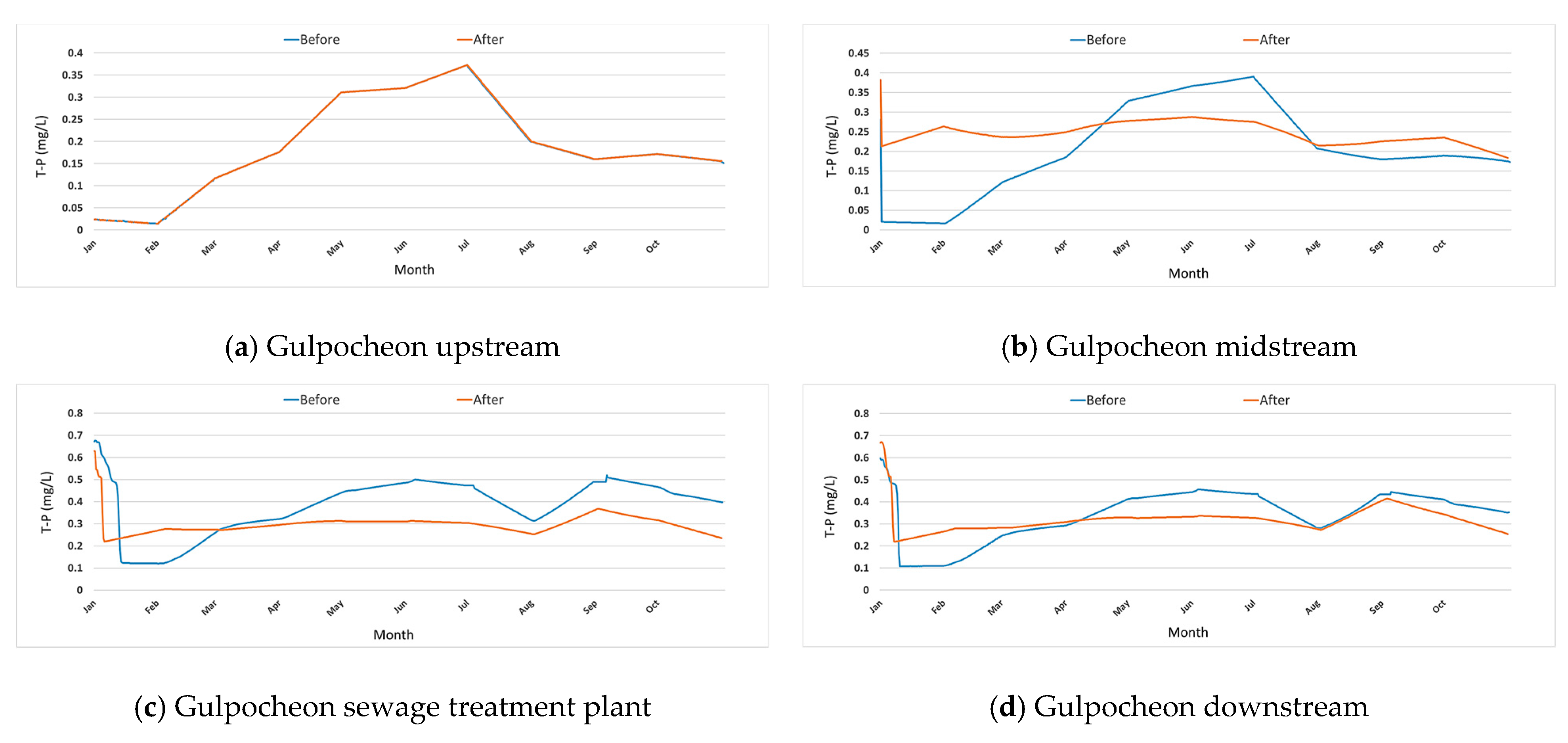
| Statistical Parameters | Upstream | Midstream | Downstream | |||||||||
|---|---|---|---|---|---|---|---|---|---|---|---|---|
| DO (mg/L) | BOD (mg/L) | TN (mg/L) | TP (mg/L) | DO (mg/L) | BOD (mg/L) | TN (mg/L) | TP (mg/L) | DO (mg/L) | BOD (mg/L) | TN (mg/L) | TP (mg/L) | |
| Average | 7.04 | 4.01 | 4.59 | 0.17 | 9.05 | 10.07 | 8.02 | 0.33 | 6.70 | 7.16 | 7.20 | 0.32 |
| Minimum | 2.3 | 1.2 | 1.689 | 0.017 | 2.9 | 1.7 | 3.807 | 0.109 | 1.9 | 2.6 | 3.795 | 0.139 |
| Maximum | 12.4 | 9.7 | 11.593 | 0.522 | 16.2 | 46 | 15.642 | 1.068 | 10.4 | 20.1 | 11.946 | 1.759 |
| S.D. | 2.81 | 2.39 | 2.75 | 0.12 | 3.06 | 10.56 | 2.74 | 0.25 | 2.44 | 3.54 | 2.04 | 0.26 |
| Item | Contents | |
|---|---|---|
| Model composition | Grid composition | Unstructured triangular grid system |
| Number of grids | Number of grids for practical calculation: 905 | |
| Simulation conditions | Flow input data | Gulpocheon inflow discharge: 2018 measured flow (Water Environment Measurement Network, 2019), Gulpo sewage treatment plant discharged water (Bucheonsi, 2019), Ozone treatment facility reclaimed water (Incheon Environment Corporation, 2019) |
| Water quality input data | Gulpocheon measured flow: 2018 Ministry of Environment Water Environment Measurement Network data, Sewage treatment discharged flow: 2018 Gulpo sewage treatment plant discharge data Ozone treatment reclaimed water discharge flow: Ozone treatment reclaimed water discharge flow (Incheon Environment Corporation, 2019) | |
| Main water quality constants | BOD process: 1st order decay (dissolved) = 0.5/d Oxygen process: Secchi disk depth = 0.4 m, Temp. Coef. respiration = 1.08, Half-saturation Conc. = 2 g/L Nitrification: 1st order decay rate = 0.05/d, Oxygen demand by nitrification, NH4 to NO2 = 3.42, Half-Sat. oxygen Conc. = 2 mg/L Phosphorus process: Phosphorus content in dissolved BOD = 0.06, Half-Sat. Conc. for P-uptake = 0.005 mg/L | |
| Simulation period | Before supply of the reclaimed water: January to October, a total of 300 days (2018) After the supply of the reclaimed water: January to October, a total of 300 days (2018) | |
| Calculation time step and coefficients | Minimum time step = 0.01 s, Eddy coefficient = 0.28, Manning’s roughness coefficient (river bed condition) = 1/32 | |
| Simulation case | Case 1: Conditions of not discharging the ozone-treated reclaimed wastewater Case 2: Conditions of discharging the ozone-treated reclaimed wastewater | |
| W.Q. Parameters | Statistical Parameters | Original Condition | After the Supply of the Ozone Treated Reclaimed Wastewater | Change Ratio | ||||||||
|---|---|---|---|---|---|---|---|---|---|---|---|---|
| Up | Mid | Gulpo STP | Down | Ave. | Up | Mid | Gulpo STP | Down | Ave. | |||
| BOD (mg/L) | Average | 4.07 | 3.71 | 1.58 | 2.62 | 3.00 | 4.12 | 1.92 | 1.82 | 1.30 | 2.29 | −30.8 |
| Minimum | 1.75 | 1.63 | 0.84 | 2.00 | 1.55 | 1.75 | 1.05 | 1.35 | 1.02 | 1.29 | −20.3 | |
| Maximum | 9.53 | 8.21 | 2.80 | 3.56 | 6.03 | 9.53 | 3.60 | 3.13 | 2.81 | 4.77 | −26.3 | |
| S.D. | 1.88 | 1.56 | 0.27 | 0.36 | 1.02 | 1.86 | 0.56 | 0.32 | 0.20 | 0.73 | −38.7 | |
| DO (mg/L) | Average | 7.92 | 8.16 | 7.86 | 7.68 | 7.91 | 7.74 | 10.42 | 9.06 | 8.83 | 9.01 | 12.3 |
| Minimum | 4.04 | 5.13 | 4.59 | 4.86 | 4.65 | 4.04 | 8.66 | 6.51 | 5.80 | 6.25 | 25.6 | |
| Maximum | 13.15 | 13.17 | 13.66 | 13.16 | 13.29 | 13.19 | 12.86 | 13.26 | 13.64 | 13.24 | −0.4 | |
| S.D. | 2.49 | 2.39 | 2.85 | 2.55 | 2.57 | 2.37 | 1.23 | 2.02 | 2.35 | 1.99 | −28.8 | |
| TN (mg/L) | Average | 3.26 | 3.21 | 3.50 | 3.87 | 3.46 | 3.27 | 6.29 | 5.67 | 5.17 | 5.10 | 32.2 |
| Minimum | 2.64 | 2.58 | 1.61 | 2.35 | 2.29 | 2.64 | 5.20 | 3.59 | 2.62 | 3.51 | 34.7 | |
| Maximum | 3.99 | 4.32 | 7.41 | 7.55 | 5.82 | 3.99 | 8.85 | 9.06 | 8.93 | 7.71 | 24.5 | |
| S.D. | 0.40 | 0.36 | 1.45 | 1.22 | 0.86 | 0.40 | 0.99 | 1.68 | 1.92 | 1.24 | 31.2 | |
| TP (mg/L) | Average | 0.19 | 0.21 | 0.38 | 0.34 | 0.28 | 0.20 | 0.25 | 0.30 | 0.32 | 0.27 | −6.3 |
| Minimum | 0.01 | 0.02 | 0.12 | 0.11 | 0.06 | 0.01 | 0.18 | 0.22 | 0.22 | 0.16 | 59.4 | |
| Maximum | 0.37 | 0.39 | 0.68 | 0.64 | 0.52 | 0.37 | 0.38 | 0.63 | 0.67 | 0.51 | −1.0 | |
| S.D. | 0.10 | 0.11 | 0.12 | 0.11 | 0.11 | 0.10 | 0.03 | 0.04 | 0.05 | 0.06 | −99.3 | |
Publisher’s Note: MDPI stays neutral with regard to jurisdictional claims in published maps and institutional affiliations. |
© 2021 by the author. Licensee MDPI, Basel, Switzerland. This article is an open access article distributed under the terms and conditions of the Creative Commons Attribution (CC BY) license (https://creativecommons.org/licenses/by/4.0/).
Share and Cite
Jang, D. Analysis of the Water Quality Improvement in Urban Stream Using MIKE 21 FM. Appl. Sci. 2021, 11, 8890. https://doi.org/10.3390/app11198890
Jang D. Analysis of the Water Quality Improvement in Urban Stream Using MIKE 21 FM. Applied Sciences. 2021; 11(19):8890. https://doi.org/10.3390/app11198890
Chicago/Turabian StyleJang, Dongwoo. 2021. "Analysis of the Water Quality Improvement in Urban Stream Using MIKE 21 FM" Applied Sciences 11, no. 19: 8890. https://doi.org/10.3390/app11198890
APA StyleJang, D. (2021). Analysis of the Water Quality Improvement in Urban Stream Using MIKE 21 FM. Applied Sciences, 11(19), 8890. https://doi.org/10.3390/app11198890






